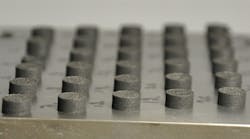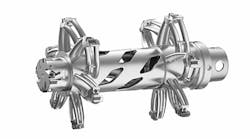VTT Technical Research Centre of Finland is leading a European consortium 3DREMAG which is developing a new material suitable for 3D printing of permanent magnets, which can be used in electric and hybrid vehicle motors. The aim, in the long run, is to develop a fully 3D printable electric motor, one that would be approximately 30% lighter than today's motors.
The new permanent magnet material being developed will promote cleaner traffic and help reduce the environmental impact of traffic. Traffic is the world's second-largest source of climate emissions and requires new sustainable solutions. By the end of 2020, the global number of electric cars will exceed 10 million. It is expected to reach 125 million by 2030.
More than 90% of electric vehicle motors are based on permanent magnets, which provide high power in a small volume. Unlike electromagnets which require continuous electrical current in order to maintain their magnetism, permanent magnets do not require an external magnetic field. The strongest permanent magnets are based on a combination of neodymium, iron, and boron (Nd-Fe-B).
Today, the production of fully dense permanent magnets is limited to simple shapes. The Nd-Fe-B powder developed under the 3DREMAG project will enable the production of magnets through 3D printing. 3D printing can be used to optimize the size of magnets and to improve resource efficiency. This is important because neodymium is a rare raw material with limited availability.
Nd-Fe-B powder can be used to produce fully dense metallic and resource-efficient permanent magnets for electric and hybrid vehicle motors, electric bicycles, and consumer electronics, as well as for wind turbine generators.
"In the long run, our goal is to construct a fully 3D printable electric motor that would be approximately 30% lighter than today's motors. Achieving this goal requires multidisciplinary cooperation and combining different technologies,” says Joni Reijonen, Research Scientist and Project Manager at VTT.
"This research project aims to implement complex, multilayered structures for 3D-printable permanent magnet components. It will enable new features such as segmentation and direct integration which increase the efficiency of electric motors. This solution can significantly enhance the conscious utilization of scarce materials,” says Carsten Schuh, Head of the Siemens Technology Unit “Functional Materials and Manufacturing Processes”.
The 3DREMAG project, coordinated by VTT Technical Research Centre of Finland and funded by EIT Raw Materials, involves research partners Commissariat à l’énergie atomique et aux énergies alternatives, CEA (French Alternative Energies and Atomic Energy Commission), Fraunhofer-Gesellschaft zur Förderung der angewandten Forschung e.V. (Fraunhofer IWKS) and Technical University Darmstadt (Research Group Functional Materials), as well as the industry partners Less Common Metals, Tekna and Siemens. The total budget of the project is approximately EUR 1.8 million for 2020-2021.














